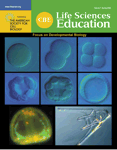Focus: Issues in Developmental Biology Education
Welcome to this special focus section of CBE—Life Sciences Education. A large portion of this issue deals with aspects of teaching and learning in a particular subdiscipline of the life sciences: developmental biology.
The field of developmental biology has progressed rapidly over the past two decades. The modern synthesis of molecular and genetic approaches in model organisms, comparative and evolutionary insights from genomics, use of increasingly sophisticated microscopy techniques, and application of this knowledge to human biology have thrust developmental biology to the forefront of not only science journals but also the public consciousness. A stream of recent Nobel prizes in Physiology or Medicine awarded for work in developmental biology attests to its importance as a central aspect of modern life science. Issues such as therapeutic and reproductive cloning and stem cell biology grab headlines. Clearly, thinking well about how to communicate the fundamental features of developmental biology to the students of today and tomorrow is important. This issue of CBE-LSE contributes to what we hope will be an increasing focus on developmental biology education in the twenty-first century.
Given the ascendancy of developmental biology in the current era, several key questions arise: To what extent is developmental biology a field separate from cell biology? Is it, as one of my colleagues likes to say, simply “cell biology over time,” or is it a truly separate way of knowing, with its own educational challenges that are genuinely unique to the subject? Are there special visual and conceptual challenges in teaching developmental biology that distinguish it from other subdisciplines in biology? Given the inherent ethical ramifications of developmental biology applied to humans, to what extent should ethics be incorporated into majors science courses in developmental biology? The Points of View feature in this issue by Gilbert et al. addresses some of these issues.
Given the public importance of developmental biology, another issue facing developmental biology instructors is that of increasing scientific literacy in this area. The interview with Morris Maduro by Hoopes and the articles by Gehring and Eastman and by Madhuri and Broussard deal with this issue.
Anyone who has peered through a microscope at developing embryos cannot help but be struck by how arresting they are visually. The WWW feature by Stark, the article on teaching Caenorhabditis elegans lineage analysis by Lu et al., and the essay on using photomicrographs by Watson and Lom examine resources and methodologies for teaching this visual aspect of developmental biology.
Finally, plant development is often left out of developmental biology discussions. The article by Spiro and Knisely provides one practical example of how to teach plant development.
Other features, articles, and essays in previous issues of CBE-LSE have also dealt with the teaching and learning of developmental biology, including the following:
WWW Features by Robert Blystone and Dennis Liu
Deformed amphibian research at Hartwick College [CBE-LSE 2(2003): 14–15; http://www.lifescied.org/cgi/content/full/2/1/14#SEC1]
C. elegans movies [CBE-LSE 2(2003): 14–15; http://www.lifescied.org/cgi/content/full/2/1/14#SEC2]
Potent cells [CBE-LSE 6(2007): 90–94; http://www.lifescied.org/cgi/content/full/6/2/90]
Video Views and Reviews by Christopher Watters
Mitosis and early development [CBE-LSE 1(2002): 111–114; http://www.lifescied.org/cgi/content/full/1/4/111#SEC3]
Angiogenesis (the development of blood vessels) [CBE-LSE 2(2003): 9–13; http://www.lifescied.org/cgi/content/full/2/1/9#SEC4]
Cytokinesis: a phenomenon overlooked too often [CBE-LSE 4(2005): 10–18; http://www.lifescied.org/cgi/content/full/4/1/10#SEC1]
Gastrulation [CBE-LSE 4(2005): 273–278; http://www.lifescied.org/cgi/content/full/4/4/273]
Neurulation and the fashioning of the vertebrate central nervous system [CBE-LSE 5(2006): 99–103; http://www.lifescied.org/cgi/content/full/5/2/99]
Book Reviews
Fink, R. D. A shelf of stem cells [CBE-LSE 3(2004): 20–21; http://www.lifescied.org/cgi/content/full/3/1/20]
Vasquez, J. From genes to embryo and beyond [CBE-LSE 6(2007): 27–28; http://www.lifescied.org/cgi/content/full/6/1/27]
Articles and Essays
Fink, R. Cloning, stem cells, and the current national debate: incorporating ethics into a large introductory biology course [CBE-LSE 1(2002): 132–144; http://www.lifescied.org/cgi/content/full/1/4/132]
Gilat Brill, G., and Yarden, A. Learning biology through research papers: a stimulus for question-asking by high-school students [CBE-LSE 2(2003): 266–274; http://www.lifescied.org/cgi/content/full/2/4/266]
Knight, J. K., and Wood, W. B. Teaching more by lecturing less [CBE-LSE 4(2005): 298–310; http://www.lifescied.org/cgi/content/full/4/4/298]
Lu, F.-M. et al. WormClassroom.org: an inquiry-rich educational web portal for research resources of Caenorhabditis elegans [CBE-LSE 6(2007): 98–108; http://www.lifescied.org/cgi/content/full/6/2/98]
Salli, U. et al. Stem cell biology should be taught in high schools [CBE-LSE 6(2007): 283–284; http://www.lifescied.org/cgi/content/full/6/4/283]
We hope you enjoy this focus on issues in developmental biology education, and we welcome your suggestions regarding other potential special topics for future issues of CBE-LSE.



